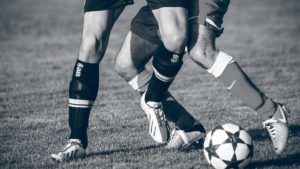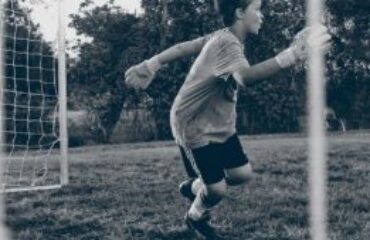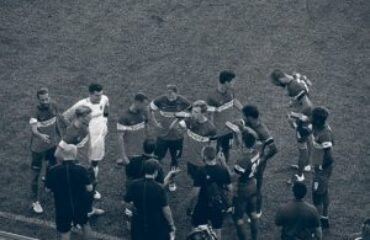1. Prevalence of binocular vision dysfunctions in professional football players
Jorge J, Diaz-Rey A, Lira M.
Clinical and Experimental Optometry Research Laboratory (Ceorlab), University of Minho, Braga, Portugal
Clin Exp Optom. 2021 Dec 9:1-7. doi: 10.1080/08164622.2021.2002667
This study examined the prevalence of binocular vision dysfunctions in 107 professional male soccer players and found that 13.0% had binocular vision dysfunctions related to esophoria, 10.3% had convergence insufficiency, 6.5% had accommodative infacility, and 3.7% had vertical phoria. The overall prevalence of binocular vision dysfunction in elite soccer players was 36.4%. The values found point out the need to include binocular vision assessment for football players.
2. Blood Biomarkers Variations across the Pre-Season and Interactions with Training Load: A Study in Professional Soccer Players
Clemente FM et al
Instituto Politécnico de Viana do Castelo, Viana do Castelo, Portugal
J Clin Med. 2021 Nov 27;10(23):5576. doi: 10.3390/jcm10235576
This study analyses the blood measures changes after a pre-season training period in 25 professional soccer. Significant increases were found for platelets, while significant decreases were found for absolute neutrophils and monocytes count. There were significant increases in creatinine, alkaline phosphatase, C-reactive protein, cortisol, and testosterone, whereas there were significant decreases in calcium. All derived RPE measures increased after pre-season period. Moderate-to-very large positive and negative correlations were found between the training load and blood measures percentage of changes. The results indicated heavy physical loads during the pre-season, leading to a decrease in immune functions. Monitoring blood measures allows to minimize injury risk, overreaching, and overtraining.
3. The influence of muscle strength and aerobic fitness on functional recovery in professional soccer
Abbott W, Clifford T
Brighton and Hove Albion F.C, American Express Elite Performance Centre, Lancing, UK
J Sports Med Phys Fitness. 2021 Dec 9. doi: 10.23736/S0022-4707.21.13401-2
This study examined the influence of muscle strength and aerobic fitness on recovery from competitive soccer matches in 14 players from the English Premier League 2. The isometric mid-thigh pull strength test was positively correlated with the recovery of countermovement jump height , reactive strength index, and muscle soreness following matches, indicating that stronger players recovered quicker after matches.
4. The influence of sleep quality and quantity on soccer injuries in professional teams
Yabroudi MA et al
Jordan University of Science and Technology, Irbid, Jordan
J Sports Med Phys Fitness. 2021 Dec 9. doi: 10.23736/S0022-4707.21.13016-6
This study in 152 professional soccer players, men (n=91), and women (n=61) reports that lower total sleeping time during off-season, answering no on “did you regularly get enough sleep during off-season”, and answering no on “do you think that your sleeping hours during off-season were enough” associated significantly with occurrence of soccer injuries during the season. This highlights the influence of sleeping quantity and quality off-season on the occurrence of soccer injuries among professional players.
5. Hamstring injury patterns in professional male football (soccer): a systematic video analysis of 52 cases
Gronwald T, Klein C, Hoenig T, Pietzonka M, Bloch H, Edouard P, Hollander K
Institute of Interdisciplinary Exercise Science and Sports Medicine, MSH Medical School Hamburg, Hamburg, Germany
Br J Sports Med. 2021 Dec 7:bjsports-2021-104769. doi: 10.1136/bjsports-2021-104769
This study analysed video footage from four seasons (2014-2019) of the two highest divisions in German male football. 52 cases of hamstring injuries were included, 25 sprint-related (48%) and 27 stretch-related (52%). All sprint-related hamstring injuries occurred during linear acceleration or high-speed running. Stretch-related hamstring injuries related to a rapid change of movement involving knee flexion to knee extension with a knee angle of <45° at the assumed injury frame. Despite the variety of inciting events, rapid movements with high eccentric demands of the posterior thigh are likely the main hamstring injury mechanism.
6. Return to play after treating acute muscle injuries in elite football players with radial extracorporeal shock wave therapy
Morgan JPM, Hamm M, Schmitz C, Brem MH
Faculty of Medicine, LMU Munich, Munich, Germany
J Orthop Surg Res. 2021 Dec 7;16(1):708. doi: 10.1186/s13018-021-02853-0
This retrospective study of 20 acute muscle injuries (8 Type 1a, 5 Type 2b, 4 Type 3a and 3 contusions) in players of an elite football team competing in the German Bundesliga during one season, treated with a multimodal therapy approach that includes a specific protocol of almost daily radial extracorporeal shock wave therapy (rESWT) found that, compared with data reported by Ekstrand et al. (Br J Sports Med 47:769-774, 2013), lay-off times were shortened by an average of 58% for Type 1a injuries, by 55% for Type 2b injuries and by 21% for Type 3a injuries, without adverse effects.
7. Running Performance and Hormonal, Maturity and Physical Variables in Starting and Non-Starting Elite U14 Soccer Players During a Congested Match Schedule
Zanetti V, Aoki MS, Bradley P, Carling C, Marino TK, Moreira A
University of Sao Paulo, Sao Paulo, Brazil
J Hum Kinet. 2021 Oct 31;80:287-295. doi: 10.2478/hukin-2021-0096
This study examined changes in match running performance in Under-14 soccer during a congested match schedule. A significant difference was observed for the frequency of decelerations (DEC) across matches, with no differences observed for total running distance, high-speed running distance, and frequency of accelerations. The findings suggest that DEC was the most pertinent variable for monitoring changes in match running performance in youth soccer during a congested match schedule.
8. The Dirty League: English Premier League Provides Higher Incentives for Fouling as Compared to Other European Soccer Leagues
Phatak AA, Rein R, Memmert D
German Sports University, Cologne, Germany
J Hum Kinet. 2021 Oct 31;80:263-276. doi: 10.2478/hukin-2021-0095
The present study used three separate linear regression models to investigate fouling as a factor influencing performance in European soccer leagues. Out of possession fouls seem to predict success (lower goals conceded and higher points) across European soccer leagues, with English Premier League showing the maximum effect.
9. Analysis of more than 20,000 injuries in European professional football by using a citizen science-based approach: An opportunity for epidemiological research?
Hoenig T, Edouard P, Krause M, Malhan D, Relógio A, Junge A, Hollander K
University Medical Center Hamburg-Eppendorf, Germany
J Sci Med Sport. 2021 Nov 18:S1440-2440(21)00515-6. doi: 10.1016/j.jsams.2021.11.038
This study analyzes the information provided by Transfermarkt.com in the section “injury history” of football players from the top five European leagues over a period of ten seasons (2009/10-2018/19) and compared it with three previously published databases (a scientific injury surveillance, a media-based study, and an insurance database). Incidence was 0.63 injuries per player-season, and in comparison to other databases, this citizen science-based data was associated with lower injury incidences and higher proportions of severe injuries.
10. Outcomes of revision anterior cruciate ligament reconstruction in soccer players : a cohort study
MARS Group
Bone Jt Open. 2021 Dec;2(12):1043-1048. doi: 10.1302/2633-1462.212.BJO-2021-0145.R1
This study evaluated 33 male and 39 female soccer players following arthroscopic revision of ACL reconstruction (rACLR). 63% of athletes returned to soccer a mean 9.6 months (SD 5.8) after the revision surgery but participation in soccer decreased to just 19% at a mean of 6.4 years later. Females were more likely than males to have subsequent knee surgery following rACLR (20% vs 5%), but the rate of recurrent graft tear (5.6%) was similar between males and females.
11. Hamstring and ACL injuries impacts on hamstring-to-quadriceps ratio of the elite soccer players: A retrospective study
Alizadeh S, Sarvestan J, Svoboda Z, Alaei F, Linduška P, Ataabadi PA
Memorial University of Newfoundland, St. John’s, Newfoundland and Labrador, Canada
Phys Ther Sport. 2021 Dec 5;53:97-104. doi: 10.1016/j.ptsp.2021.12.001
This study compared the isokinetic strength angle-specific (AS) and non-angle-specific (NAS) hamstring to quadriceps conventional and functional ratios between healthy, and 111 hamstring- and ACL-injured elite soccer players. Healthy players produced greater functional and conventional ratios compared to players with either ACL or hamstring injury. Players with hamstring injury produced a lower AS functional ratios between 46° and 54° of knee flexion. Players suffering from ACL injury depicted a lower value for the AS functional ratio between 33° and 56° of knee flexion.





